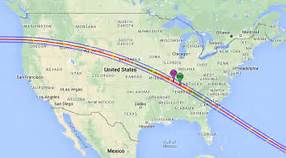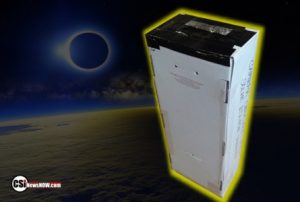 LOS ANGELES (AP) — Monday’s solar eclipse is set to star in several special broadcasts on TV and online.
LOS ANGELES (AP) — Monday’s solar eclipse is set to star in several special broadcasts on TV and online.
On CSi Cable10 or go to: PBS 13, ABC 6, NBC 11, NASA Television 80.76, The Weather Channel 39, and the various news channels are among the outlets planning extended coverage of the first solar eclipse visible across the United States in 99 years.
Most coverage begins Monday at noon CDT, just before the eclipse begins in Oregon.
Observing or filming the eclipse in its partial phases requires special lenses, but witnessing the complete obfuscation of the sun is safe with the naked eye.
Live views from NASA at YouTube
Jamestown (CSi) On Monday’s Wayne Byers Show on CSi Cable 2, Dr. Timothy  Bratton an amateur astronomer from Jamestown and retired professor from the University of Jamestown explained what the partial solar eclipse on Monday in Jamestown holds in store for Jamestown viewers.
Bratton an amateur astronomer from Jamestown and retired professor from the University of Jamestown explained what the partial solar eclipse on Monday in Jamestown holds in store for Jamestown viewers.
He said North Dakota is too far north of the Moon’s umbral (central shadow) path for a total eclipse to be seen from Jamestown.
He added, “Nevertheless, we’ll witness a very good partial eclipse. I wrote this on the road when I did not have access to my usual computers, but I’ve simulated the eclipse on my iPad Mini using three applications, EclipseCalculator, Black Sun, and Sky Safari, and the online calculator provided by the U.S. Naval Observatory.
Here’s what they predict will happen in Jamestown:
11:35:45 p.m., CDT: Both the Sun and the Moon will be roughly 46 degrees over our city’s SE horizon. At that instant the Moon, just to the Sun’s upper right, will take a small “bite” out of the solar disk as it begins to move across the star.
12:31 p.m.: New Moon occurs technically as both solar system bodies share the same ecliptic longitude.
12:54:08 p.m.: Maximum eclipse occurs as the Moon moves almost directly south of the Sun’s center, with both objects 54 degrees above the SSE horizon. The eclipse’s magnitude from our location is 85.2%, which means that the Moon will cover that percentage of the Sun’s diameter. However, since both bodies are spheres, the obscuration (percentage of the apparent surface area of the star covered by the Moon) will be smaller at 82%. Looking at the Sun through approved solar eclipse glasses, you would perceive a brilliant solar crescent, with its cusps facing down. At this moment the Moon will be 228,132.7 miles away, while the Sun will lie 94,013,461 miles from Earth. Because the Moon is pretty close to us, its apparent diameter is 32.5 minutes of arc, while the Sun appears 31.5 arc-minutes wide. This is why the lucky people to the south of us will see a total solar eclipse; the Moon’s disk will cover the star completely.
2:17:52 p.m.: The eclipse ends as the Moon’s rim departs from the lower left of the Sun.
 Do not run the risk of blindness by looking directly at the Sun! There are only two safe ways to view the eclipse. Aluminized Mylar sunglasses, which you still might be able to purchase from reliable astronomy websites, reflect back 99.99% of the Sun’s rays; in such glasses, the Sun will appear blue (but safe to see). You can also make a pinhole camera. Take a shoebox, cut a small hole in one end, cover it with aluminum foil (tape it in place), and make a tiny pinprick in the foil. When you hold it up with the pinprick facing toward the Sun, you should see a tiny bright projected image of the star projected on the BACK of the shoebox (don’t look directly at the Sun through the hole!). You can find instructions for making such a device online. NEVER USE FIELD GLASSES, BINOCULARS, OR A TELESCOPE to look at the Sun, UNLESS each has a specially fitted aluminized Mylar solar filter mounted safely on the front of the instrument; you could fry your retina in seconds were you foolish enough to do this without such filters! Solar eclipses are wonderful to behold, but caution is needed.
Do not run the risk of blindness by looking directly at the Sun! There are only two safe ways to view the eclipse. Aluminized Mylar sunglasses, which you still might be able to purchase from reliable astronomy websites, reflect back 99.99% of the Sun’s rays; in such glasses, the Sun will appear blue (but safe to see). You can also make a pinhole camera. Take a shoebox, cut a small hole in one end, cover it with aluminum foil (tape it in place), and make a tiny pinprick in the foil. When you hold it up with the pinprick facing toward the Sun, you should see a tiny bright projected image of the star projected on the BACK of the shoebox (don’t look directly at the Sun through the hole!). You can find instructions for making such a device online. NEVER USE FIELD GLASSES, BINOCULARS, OR A TELESCOPE to look at the Sun, UNLESS each has a specially fitted aluminized Mylar solar filter mounted safely on the front of the instrument; you could fry your retina in seconds were you foolish enough to do this without such filters! Solar eclipses are wonderful to behold, but caution is needed.
The next solar eclipse visible from Jamestown will be a partial solar eclipse on June 10, 2021, in which merely 6.5% of the Sun’s surface will be hidden by the Moon.
The next total solar eclipse to be visible in Jamestown will be September 14, 2099.
SAFETY
The President of the American Optometric Association says you can literally cook your retina, and that part of the eye cannot register a pain feeling with your brain. You’re damaging your eyes and don’t even know it. Sunglasses are not safe, looking through your phone’s camera lens is not safe, and even quick glances at the eclipse can cause injury.
You should NEVER look directly at the sun, but there are many ways to safely view an eclipse. There are filters for binoculars and telescopes designed specifically for looking at the sun. Inexpensive eclipse glasses and viewers are also available for purchase. Or,  you can make your own pinhole projector. You can make a tiny “theater” with a cardboard box, foil, and paper, or it can be as simple as poking a tiny hole in a paper plate. As mentioned above, you can also safely view the eclipse via television or live stream.
you can make your own pinhole projector. You can make a tiny “theater” with a cardboard box, foil, and paper, or it can be as simple as poking a tiny hole in a paper plate. As mentioned above, you can also safely view the eclipse via television or live stream.













Comments are closed
Sorry, but you cannot leave a comment for this post.